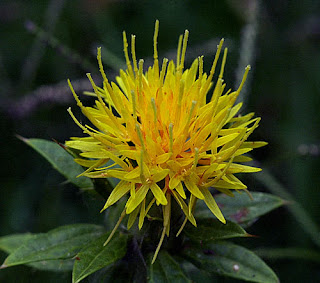Safflower
Safflower (Carthamus tinctorius L.) is a highly branched, herbaceous, thistle-like annual, usually with many long sharp spines on the leaves.
Plants are 30 to 150 cm tall with globular flower heads (capitula) and commonly, brilliant yellow, orange or red flowers which bloom in July.
Each branch will usually have from one to five flower heads containing 15 to 20 seeds per head. Safflower has a strong taproot which enables it to thrive in dry climates, but the plant is very susceptible to frost injury from stem elongation to maturity
Uses
Traditionally, the crop was grown for its seeds, and used for colouring and flavouring foods and making red (carthamin) and yellow dyes, especially before cheaper aniline dyes became available, and in medicines.
For the last fifty years or so, the plant has been cultivated mainly for the vegetable oil extracted from its seeds. In April 2007 it was reported that genetically modified safflower has been bred to create insulin.
Carthamus tinctoriusSafflower oil is flavorless and colorless, and nutritionally similar to sunflower oil.
It is used mainly as a cooking oil, in salad dressing, and for the production of margarine. It may also be taken as a nutritional supplement.
INCI nomenclature is Carthamus tinctorius.
Safflower flowers are occasionally used in cooking as a cheaper substitute for saffron, and are thus sometimes referred to as "bastard saffron." Safflower seed is also used quite commonly as an alternative to sunflower seed in birdfeeders, as squirrels do not like the taste of it.
There are two types of safflower that produce different kinds of oil: one high in monounsaturated fatty acid (oleic acid) and the other high in polyunsaturated fatty acid (linoleic acid).
Currently the predominant oil market is for the former, which is lower in saturates than olive oil, for example.
Safflower oil is also used in painting in the place of linseed oil, particularly with white, as it does not have the yellow tint which linseed oil possesses.
Lana is a strain of Safflower that grows in the southwestern United States, most notably Arizona and New Mexico.
History
Safflower is one of humanity's oldest crops.
Chemical analysis of ancient Egyptian textiles dated to the Twelfth dynasty identified dyes made from safflower, and garlands made from safflowers were found in the tomb of the pharaoh Tutankhamun.
John Chadwick reports that the Greek name for safflower occurs many times in Linear B tablets, distinguished into two kinds: a white safflower, which is measured, and red which is weighed.
"The explanation is that there are two parts of the plant which can be used; the pale seeds and the red florets."
Safflower was also known as carthamine in the 19th century.
It is a minor crop today, with about 600,000 tons being produced commercially in more than sixty countries worldwide.
India, United States, and Mexico are the leading producers, with Ethiopia, Kazakhstan, China, Argentina and Australia accounting for most of the remainder.

